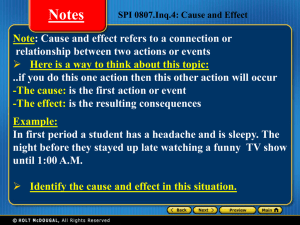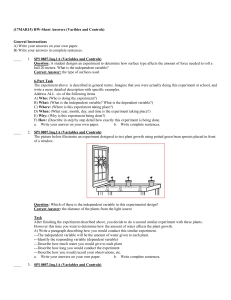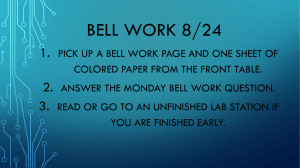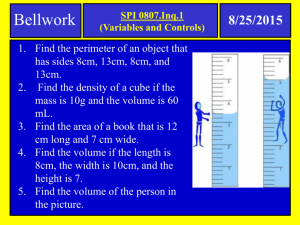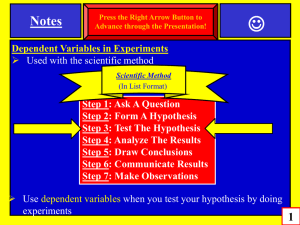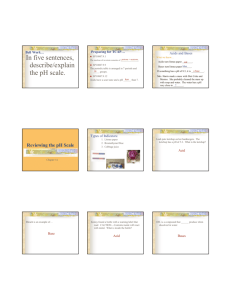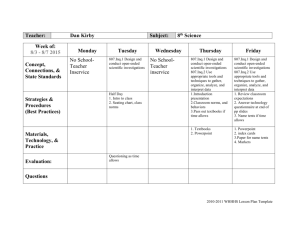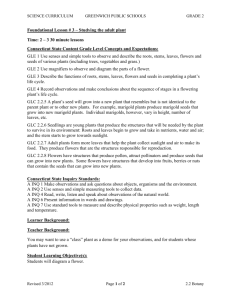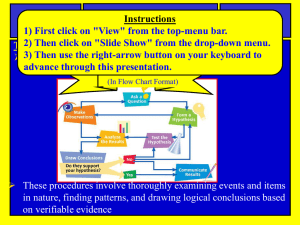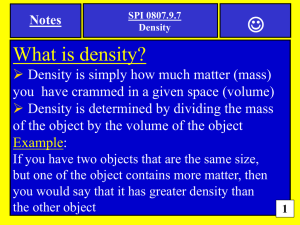Week 6: Ocean Exploration
advertisement
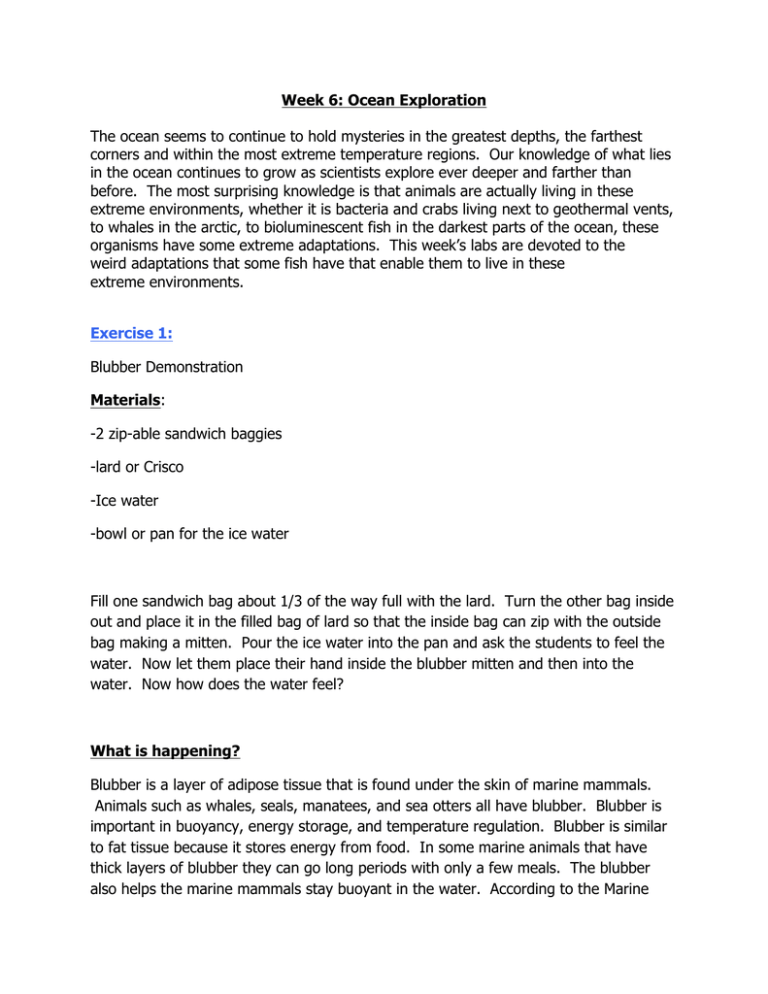
Week 6: Ocean Exploration The ocean seems to continue to hold mysteries in the greatest depths, the farthest corners and within the most extreme temperature regions. Our knowledge of what lies in the ocean continues to grow as scientists explore ever deeper and farther than before. The most surprising knowledge is that animals are actually living in these extreme environments, whether it is bacteria and crabs living next to geothermal vents, to whales in the arctic, to bioluminescent fish in the darkest parts of the ocean, these organisms have some extreme adaptations. This week’s labs are devoted to the weird adaptations that some fish have that enable them to live in these extreme environments. Exercise 1: Blubber Demonstration Materials: -2 zip-able sandwich baggies -lard or Crisco -Ice water -bowl or pan for the ice water Fill one sandwich bag about 1/3 of the way full with the lard. Turn the other bag inside out and place it in the filled bag of lard so that the inside bag can zip with the outside bag making a mitten. Pour the ice water into the pan and ask the students to feel the water. Now let them place their hand inside the blubber mitten and then into the water. Now how does the water feel? What is happening? Blubber is a layer of adipose tissue that is found under the skin of marine mammals. Animals such as whales, seals, manatees, and sea otters all have blubber. Blubber is important in buoyancy, energy storage, and temperature regulation. Blubber is similar to fat tissue because it stores energy from food. In some marine animals that have thick layers of blubber they can go long periods with only a few meals. The blubber also helps the marine mammals stay buoyant in the water. According to the Marine Mammal Center blue whales weigh 200,000 to 300,000lbs on average. That is 100 tons! Without blubber, the whales would be negatively buoyant and have a much harder time swimming. Blubber also helps keep the animals insulated. Unlike fat found in land animals blubber has many blood vessels located throughout the tissue. These blood vessels will contract when the animal is in cold temperatures keeping the body temperature stable. The amount of blubber an animal has varies with the species; some only have a few inches while others like the whale can have over a foot of blubber! In this demonstration, the lard is acting like blubber and works as an insulator. How this relates to Jessica and Bruce: Not all the oceans are the same temperatures. In fact, some oceans are very cold. Animals that live in the oceans are adapted to the cold water by having blubber. This blubber tissue will keep the animal insulated. People do not have blubber to keep them warm in cold temperatures. When people dive, they are subjected to the water temperatures. Water conducts heat 20 times faster than air, which means that most divers need very warm waters to feel comfortable without an exposure suit. A diver may be comfortable in a room 70oF but they may be very cold in 70oF water. If divers are diving in extreme environments like ice diving they have to wear exposure suits. There are many types of exposure suits. For example dry suits and heated suits are common for cold water diving. Definitions: -Blubber: A thick layer of vascularized adipose tissue found under the skin of all marine mammals. -Adipose tissue: Connective tissue in which fat is stored and which has the cells distended by droplets of fat Questions: 1. What is blubber? 2. Why is blubber important for animals? 3. What do humans have that is similar to blubber? 4. If the blood vessels in blubber constrict to keep and animal warm, what happens to the blood vessels if the animal gets hot? 5. Are animals with blubber able to travel to warm places or warm waters? Related topics: What animals prefer the colder oceans? Do these animals sometimes migrate to warm waters? Counter current exchange to regulate body temperatures Exercise 2: Bioluminescence Make Water Glow! Teachers: Either you can grow your own bioluminescent organism by buying a bioluminescence kit or, you can use the cheaper version and make water glow. While glowing water is not exactly the same thing as bioluminescence, it does demonstrate the concept for the students. I have included links that sell the bioluminescence kit but they can be very expensive. These are just two that I found please feel free to shop around! http://seafarms.com/html/products.html http://empco.org/edu/index.php/bioluminescent-algae.html Materials: -A black light -Tonic water or a highlighter -A dark room -pictures of animals that have bioluminescence are useful If you are using a highlighter, then gently pull out the felt insides of the marker and cut the plastic wrapping with a knife. Soak the felt insides in water. Then take the highlighter water or the tonic water and illuminate it in a dark room with a black light. What do you see? What is happening? When it comes to seeing light and wavelengths, humans see only the visible spectrum. The visible spectrum is a portion of the electromagnetic spectrum that is visible to the naked eye, these are wavelengths of approximately 400-750nm (nanometers). Humans can see colors such as violet, blue, green, yellow, orange, and red. The violet wavelengths are the shortest around 400nm and reds are the longest wavelengths about 750nm. Ultra violet light has shorter wavelengths than visible light. The wavelength range for ultraviolet light is 10nm-400nm, which means it is shorter than visible light but longer than x-ray wavelengths. When UV light is shone on the tonic water and the highlighter water, they glow. The tonic water and the highlighter ink both contain phosphors, which are substances that emit light when excited by radiation. In this lab, the UV light is the radiation that excites the phosphors to produce light. The act of emitting light is known as luminescence. How this relates to Jessica and Bruce: Fireflies, glowworms, certain fish, jellyfish, plankton, fungi, and bacteria have a unique characteristic in common, bioluminescence. Bioluminescence is the emission of light from a living organism. Think of a firefly or lightening bug for example, the tip of the body produces a yellow flash of light at night as a way to attract a mate. This production of light by the firefly is bioluminescence. In the ocean, many organisms produce bioluminescence as a way to attract food, hide from predators, and communicate. Many people who live by the ocean may have seen bioluminescence in the form of algal blooms, commonly referred to as Red Tide, where presence of dinoflagellates is common. These dinoflagellates produce a flash of light when disturbed. At night, waves disturb the dinoflagellates that results in what appears to be the waves lighting up. Boat motors, kayaks, and surfers all disturb the dinoflagellates resulting in waves of light in the wake. Many divers have noticed this bioluminescence when doing night dives. When the divers turn off their lights and wave their hands around in the water column it disturbs the bioluminescence plankton or algae that may be present creating a scene of glittery, sparkles in the water. 2011 Algal bloom in San Diego California: https://www.youtube.com/watch?v=9HcQlQlKt2w Finding Nemo: https://www.youtube.com/watch?v=y9ZgTXDJb0U Definitions: -Electromagnetic spectrum- The range of wavelengths or frequencies over which electromagnetic radiation extends from gamma rays to the longest radio waves and including visible light. -Visible light-The range of the electromagnetic radiation that can be detected by the human eye. ~400nm-750nm -Ultra violet- A form of radiation, which is not visible to the human eye. -Luminescence- The emission of light as a result of the excitation of atoms by energy other than heat. -Wavelengths-The distance between successive crests of a wave, especially points in a sound wave or electromagnetic wave. -Phosphors- any number of substances that exhibit luminescence when struck by light of a certain wavelength. -Bioluminescence- The production of light by a living organism. -Dinoflagellates- a single celled organism with two flagella, occurring in large numbers in marine plankton and found in fresh water. -Harmful Algal Blooms- occur when colonies of algae grow out of control while producing toxic or harmful effects on people, fish, shellfish, marine mammals, and birds. These are commonly referred to as red tides. Questions: 1. What is visible light? 2. What is Ultra Violet light? 3. What specifically caused the water to glow? 4. How does bioluminescence help fish who live in the darkest parts of the ocean? 5. How can bioluminescence help organisms communicate? Related topics: -UV light from the sun is what causes tanning and sunburn. -Jessica and Bruce will be living without any UV light what happens to their Vitamin D levels. -thymine dimmers from UV exposure -cancer from UV light -Red Tide -Deep sea fish with bioluminescence Paint your bioluminescence Here is a fun alternative to making water glow: http://ocean.si.edu/blog/using-light-painting-teach-bioluminescence Exercise 3: Making Goo Materials: -corn starch (1 cup) -water -a baking pan or container -newspaper -measuring cup Teachers: Lay out newspapers in the area where students will be playing with the goo. This can be VERY messy so make sure you have a spread of newspapers and plenty of paper towels. Also take special care to dispose of the goo carefully if you pour it down the sink make sure you dilute it first so you don't clog the drains. Mix one cup of cornstarch with 1/2 cup of water in the baking pan. Gently mix. The goo should have a liquidly consistency when stirred slowly. If tapped quickly the goo should not splash. Have students grab handfuls of goo and let it run in between their fingers. Then have students grab handfuls of goo and quickly roll it into a ball. What happens when they stop rolling the ball? What is happening? Mixing the cornstarch and water makes a colloid, small solid particles suspended in water. Colloids are known as non-Newtonian fluids, which, means they do not behave the same way water does. When students run their fingers through the goo slowly, it behaves like a liquid. If students try to stir it, the goo becomes hard and acts like a solid. That is because the students are applying pressure in the form of a sideways shearing force, which causes the viscosity of the ooze to change. This means that when force is applied to the goo the ability of the liquid to flow decreases. When the goo is being stirred slowly, it allows the molecules to move around each other. When the goo is stirred quickly, the force pushes the molecules into each other making it act like a solid. This is why when the students are applying force the goo can be shaped into a ball but as soon as the pressure is released, the molecules spread out and the goo oozes like a liquid. How this relates to Jessica and Bruce: Fish have weird adaptations for living in the ocean and the Blobfish, or Psychrolutes Maricdus is no exception. The Blobfish lives in waters off the coast of Australia and Tasmania in approximately 600-1200 meters of water. At that depth, the pressure is extremely high and the fish that live there have to have special adaptations to handle that kind of pressure. Most fish have swim bladders to help keep them buoyant however, at this depth, the bladder could not handle the pressure, and it would collapse. The Bobfish does not have a swim bladder in fact; they do not have much of anything. The Blobfish has no bones or muscles; they are composed of soft connective tissue. At depth where they live, they do not need supportive structures they rely on the external pressure to help maintain their body shape. Like the goo that students just played with the force of the water, helps give the fish its shape. When fishermen accidentally catch Blobfish in their nets and pull them up to the surface the loss of pressure causes the fish to turn into well, a blob. While this is not the exact same as what is happening with the goo, it is very similar. Humans have bones to help support themselves against the force of gravity. What would humans look like if there were no need to have muscles or a skeleton? Definitions: -Colloid: A heterogeneous mixture in which solute-like particles do not settle out. -Newtonian fluids: a fluid where the relation between the shear stress and the strain rate is linear, the constant of proportionality being the coefficient of viscosity. -Non-Newtonian fluids: a fluid whose flow properties are not described by a single constant value of viscosity. -Viscosity: the property of resistance to flow in a fluid or semifluid Questions: 1. What is a colloid substance? 2. What is Viscosity? 3. What has a higher viscosity water or honey? 4. What causes the Blobfish to look like a blob when at the surface? 5. What do you think humans would look like if they lived in areas of extreme pressures? Related topics: How do whales dive to deep depths? How deep can humans dive in exposure suits? Why do humans have skeletons? Links: Blubber: http://education.nationalgeographic.com/education/encyclopedia/blubber/?ar_a=1 http://www.marinemammalcenter.org/education/marine-mammalinformation/cetaceans/blue-whale.html http://www.stevespanglerscience.com/lab/experiments/blubber-gloves Bioluminescence http://www.sciencekids.co.nz/experiments/glowingwater.html http://biolum.eemb.ucsb.edu/organism/dinohome.html (grow at home kits) http://mps.uchicago.edu/docs/Winter06/proposals/WhoGlows.pdf Blobfish: http://www.smithsonianmag.com/smart-news/in-defense-of-the-blobfish-why-theworlds-ugliest-animal-isnt-as-ugly-as-you-think-it-is-6676336/?no-ist http://scifun.chem.wisc.edu/homeexpts/lumpyliquids.htm https://www.exploratorium.edu/science_explorer/ooze.html Answers: 1. What is blubber? a. A thick layer of vascularized adipose tissue found under the skin of all marine mammals. 2. Why is blubber important for animals? a. Buoyancy, energy storage, and temperature regulation 3. What do humans have that is similar to blubber? a. Adipose or fat tissue 4. If the blood vessels in blubber constrict to keep and animal warm, what happens to the blood vessels if the animal gets hot? a. They would dilate to allow blood flow to be exposed to colder temperatures. 5. Are animals with blubber able to travel to warm places or warm waters? a. Yes. Many whales are known to migrate to warm waters. 1. What is visible light? a. It is a portion of the electromagnetic spectrum that is visible to the naked eye, with wavelengths of 400-750nm. 2. What is Ultra Violet light? a. Light that has wavelengths shorter than visible light but longer then microwaves. These wavelengths range from 10-400nm. 3. What specifically caused the water to glow? a. The excited phosphors that release light 4. How does bioluminescence help fish who live in the darkest parts of the ocean? a. It helps them attract food, hide from predators, and to communicate 5. How can bioluminescence help organisms communicate? a. Answers will vary. Organisms can communicate with flashing light patterns and intensities. Fireflies use bioluminescence to attract a mate. 1. What is a colloid substance? a. A heterogeneous mixture in which solute-like particles do not settle out 2. What is Viscosity? a. the property of resistance to flow in a fluid or semifluid 3. What has a higher viscosity water or honey? a. Honey. It is more resistant to flow. 4. What causes the Blobfish to look like a blob when at the surface? a. The lack of external pressure 5. What do you think humans would look like if they lived in areas of extreme pressures? a. Answers will vary Tennessee State Standards: Grade 6 :Embedded Inquiry Conceptual Strand Understandings about scientific inquiry and the ability to conduct inquiry are essential for living in the 21st century. Guiding Question What tools, skills, knowledge, and dispositions are needed to conduct scientific inquiry? Grade Level Expectations GLE 0607.Inq.1 Design and conduct open- ended scientific investigations. GLE 0607.Inq.2 Use appropriate tools and techniques to gather, organize, analyze, and interpret data. GLE 0607.Inq.3 Synthesize information to determine cause and effect relationships between evidence and explanations. GLE 0607.Inq.4 Recognize possible sources of bias and error, alternative explanations, and questions for further exploration. GLE 0607.Inq.5 Communicate scientific understanding using descriptions, explanations, and models. Checks for Understanding 0607.Inq.1Design and conduct an open-ended scientific investigation to answer a question that includes a control and appropriate variables. 0607.Inq.2 Identify tools and techniques needed to gather, organize, analyze, and interpret data collected from a moderately complex scientific investigation. 0607.Inq.3 Use evidence from a dataset to determine cause and effect relationships that explain a phenomenon. 0607.Inq.4 Review an experimental design to determine possible sources of bias or error, state alternative explanations, and identify Questions for further investigations. 0607.Inq.S Design a method to explain the results of an investigation using descriptions, explanations, or models. State Performance Indicators SPI 0607.Inq.1Design a simple experimental procedure with an identified control and appropriate variables. SPI 0607.Inq.2 Select tools and procedures needed to conduct a moderately complex experiment. SPI 0607.Inq.3 Interpret and translate data in a table, graph, or diagram. SPI 0607.Inq.4 Draw a conclusion that establishes a cause and effect relationship supported by evidence. SPI 0607.Inq.5 Identify a faulty interpretation of data that is due to bias or experimental error. Grade 6 :Embedded Technology & Engineering Conceptual Strand Society benefits when engineers apply scientific discoveries to design materials and processes that develop into enabling technologies. Guiding Question How do science concepts, engineering skills, and applications of technology improve the quality of life? Grade Level Expectations GLE 0607.T/E.1Explore how technology responds to social, political, and economic needs. GLE 0607.T/E.2 Know that the engineering design process involves an ongoing series of events that incorporate design constraints, model building, testing, evaluating, modifying, and retesting. GLE 0607.T/E.3 Compare the intended benefits with the unintended consequences of a new GLE 0607.T/E.4 Describe and explain adaptive and assistive bioengineered products. Checks for Understanding 0607.T/E.1Use appropriate tools to test for strength, hardness, and flexibility of materials. 0607.T/E.2 Apply the engineering design process to construct a prototype that meets certain specifications. 0607.T/E.3 Explore how the unintended consequences of new technologies can impact society. 0607.T/E.4 Research bioengineering technologies that advance health and contribute to improvements inour daily lives. 0607.T/E.5 Develop an adaptive design and test its effectiveness. State Performance Indicators SPI 0607.T/E.1Identify the tools and procedures needed to test the design features of a prototype. SPI 0607.T/E.2 Evaluate a protocol to determine if the engineering design process was successfully applied. SPI 0607.T/E.3 Distinguish between the intended benefits and the unintended consequences of a new technology. technology. SPI 0607.T/E.4 Differentiate between adaptive and assistive engineered products (e.g., food, biofuels, medicines, integrated pest management). Grade 7 : Embedded Inquiry Conceptual Strand Understandings about scientific inquiry and the ability to conduct inquiry are essential for living in the 21st century. Guiding Question What tools, skills, knowledge, and dispositions are needed to conduct scientific inquiry? Grade Level Expectations GLE 0707.Inq.1 Design and conduct open- ended scientific investigations. GLE 0707.Inq.2 Use appropriate tools and techniques to gather, organize, analyze, and interpret data. GLE 0707.Inq.3 Synthesize information to determine cause and effect relationships between evidence and explanations. GLE 0707.Inq.4 Recognize possible sources of bias and error, alternative explanations, and questions for further exploration. GLE 0707.Inq.5 Communicate scientific understanding using descriptions, explanations, and models. Checks for Understanding 0707.Inq.1 Design and conduct an open-ended scientific investigation to answer a question that includes a control and appropriate variables. 0707.Inq.2 Identify tools and techniques needed to gather, organize, analyze, and interpret data collected from a moderately complex scientific investigation. 0707.Inq.3 Use evidence from a dataset to determine cause and effect relationships that explain a phenomenon. 0707.Inq.4 Review an experimental design to determine possible sources of bias or error, state alternative explanations, and identify questions for further investigation. 0707.Inq.5 Design a method to explain the results of an investigation using descriptions, explanations, or models. State Performance Indicators SPI 0707.Inq.1 Design a simple experimental procedure with an identified control and appropriate variables. SPI 0707.Inq.2 Select tools and procedures needed to conduct a moderately complex experiment. SPI 0707.Inq.3 Interpret and translate data in a table, graph, or diagram. SPI 0707.Inq.4 Draw a conclusion that establishes a cause and effect relationship supported by evidence. SPI 0707.Inq.5 Identify a faulty interpretation of data that is due to bias or experimental error. Grade 7 : Embedded Technology & Engineering Conceptual Strand Society benefits when engineers apply scientific discoveries to design materials and processes that develop into enabling technologies. Guiding Question How do science concepts, engineering skills, and applications of technology improve the quality of life? Grade Level Expectations GLE 0707.T/E.1 Explore how technology responds to social, political, and economic needs. GLE 0707.T/E.2 Know that the engineering design process involves an ongoing series of events that incorporate design constraints, model building, testing, evaluating, modifying, and retesting. GLE 0707.T/E.3 Compare the intended benefits with the unintended consequences of a new technology. GLE 0707.T/E.4 Describe and explain adaptive and assistive bioengineered products. Checks for Understanding 0707.T/E.1 Use appropriate tools to test for strength, hardness, and flexibility of materials. 0707.T/E.2 Apply the engineering design process to construct a prototype that meets certain specifications. 0707.T/E.3 Explore how the unintended consequences of new technologies can impact society. 0707.T/E.4 Research bioengineering technologies that advance health and contribute to improvements in our daily lives. 0707.T/E.5 Develop an adaptive design and test its effectiveness. State Performance Indicators SPI 0707.T/E.1 Identify the tools and procedures needed to test the design features of a prototype. SPI 0707.T/E.2 Evaluate a protocol to determine if the engineering design process was successfully applied. SPI 0707.T/E.3 Distinguish between the intended benefits and the unintended consequences of a new technology. SPI 0707.T/E.4 Differentiate between adaptive and assistive engineered products (e.g., food, biofuels, medicines, integrated pest management). Grade 8 : Embedded Inquiry Conceptual Strand Understandings about scientific inquiry and the ability to conduct inquiry are essential for living in the 21st century. Guiding Question What tools, skills, knowledge, and dispositions are needed to conduct scientific inquiry? Grade Level Expectations GLE 0807.Inq.1 Design and conduct open- ended scientific investigations. GLE 0807.Inq.2 Use appropriate tools and techniques to gather, organize, analyze, and interpret data. GLE 0807.Inq.3 Synthesize information to determine cause and effect relationships between evidence and explanations. GLE 0807.Inq.4 Recognize possible sources of bias and error, alternative explanations, and questions for further exploration. GLE 0807.Inq.5 Communicate scientific understanding using descriptions, explanations, and models. Checks for Understanding 0807.Inq.1 Design and conduct an open-ended scientific investigation to answer a question that includes a control and appropriate variables. 0807.Inq.2 Identify tools and techniques needed to gather, organize, analyze, and interpret data collected from a moderately complex scientific investigation. 0807.Inq.3 Use evidence from a dataset to determine cause and effect relationships that explain a phenomenon. 0807.Inq.4 Review an experimental design to determine possible sources of bias or error, state alternative explanations, and identify questions for further investigation. 0807.Inq.5 Design a method to explain the results of an investigation using descriptions, explanations, or models. State Performance Indicators SPI 0807.Inq.1 Design a simple experimental procedure with an identified control and appropriate variables. SPI 0807.Inq.2 Select tools and procedures needed to conduct a moderately complex experiment. SPI 0807.Inq.3 Interpret and translate data into a table, graph, or diagram. SPI 0807.Inq.4 Draw a conclusion that establishes a cause and effect relationship supported by evidence. SPI 0807.Inq.5 Identify a faulty interpretation of data that is due to bias or experimental error. Grade 8 : Embedded Technology & Engineering Conceptual Strand Society benefits when engineers apply scientific discoveries to design materials and processes that develop into enabling technologies. Guiding Question How do science concepts, engineering skills, and applications of technology improve the quality of life? Grade Level Expectations GLE 0807.T/E.1 Explore how technology responds to social, political, and economic needs. GLE 0807.T/E.2 Know that the engineering design process involves an ongoing series of events that incorporate design constraints, model building, testing, evaluating, modifying, and retesting. GLE 0807.T/E.3 Compare the intended benefits with the unintended consequences of a new technology. GLE 0807.T/E.4 Describe and explain adaptive and assistive bioengineered products. Checks for Understanding 0807.T/E.1 Use appropriate tools to test for strength, hardness, and flexibility of materials. 0807.T/E.2 Apply the engineering design process to construct a prototype that meets certain specifications. 0807.T/E.3 Explore how the unintended consequences of new technologies can impact society. 0807.T/E.4 Research bioengineering technologies that advance health and contribute to improvements in our daily lives. 0807.T/E.5 Develop an adaptive design and test its effectiveness. State Performance Indicators SPI 0807.T/E.1 Identify the tools and procedures needed to test the design features of a prototype. SPI 0807.T/E.2 Evaluate a protocol to determine if the engineering design process was successfully applied. SPI 0807.T/E.3 Distinguish between the intended benefits and the unintended consequences of a new technology. SPI 0807.T/E.4 Differentiate between adaptive and assistive engineered products (e.g., food, biofuels, medicines, integrated pest management). Grade 8 : Standard 5 - Biodiversity and Change Conceptual Strand 5 A rich variety of complex organisms have developed in response to a continually changing environment. Guiding Question 5 How does natural selection explain how organisms have changed over time? Grade Level Expectations GLE 0807.5.1 Identify various criteria used to classify organisms into groups. GLE 0807.5.3 Analyze how structural, behavioral, and physiological adaptations within a population enable it to survive in a given environment. GLE 0807.5.4 Explain why variation within a population can enhance the chances for group survival. GLE 0807.5.5 Describe the importance of maintaining the earth’s biodiversity. Checks for Understanding 0807.5.3 Compare and contrast the ability of an organism to survive under different environmental conditions. 0807.5.6 Prepare graphs that demonstrate how the amount of biodiversity has changed in a particular continent or biome. State Performance Indicators SPI 0807.5.2 Analyze structural, behavioral, and physiological adaptations to predict which populations are likely to survive in a particular environment SPI 0807.5.3 Analyze data on levels of variation within a population to make predictions about survival under particular environmental conditions. Grade 8 : Standard 9 - Matter Conceptual Strand 9 The composition and structure of matter is known, and it behaves according to principles that are generally understood. Guiding Question 9 How does the structure of matter influence its physical and chemical behavior? Grade Level Expectations GLE 0807.9.1 Understand that all matter is made up of atoms. GLE 0807.9.2 Explain that matter has properties that are determined by the structure and arrangement of its atoms. Checks for Understanding 0807.9.1 Identify atoms as the fundamental particles that make up matter. 0807.9.2 Illustrate the particle arrangement and type of motion associated with different states of matter. State Performance Indicators SPI 0807.9.1 Recognize that all matter consists of atoms. National Standards: Middle School Life Science: Natural Selection and Adaptations 1. Construct an explanation based on evidence that describes how genetic variations of traits in a population increase some individuals’ probability of surviving and reproducing in a specific environment. MS-LS4-4 a. Clarification Statement: Emphasis is on using simple probability statements and proportional reasoning to construct explanations. b. Assessment Boundary: none
